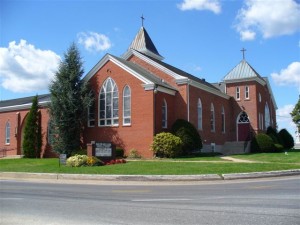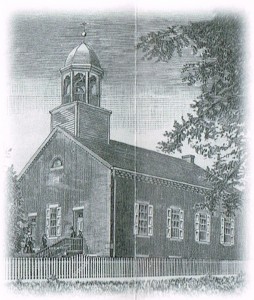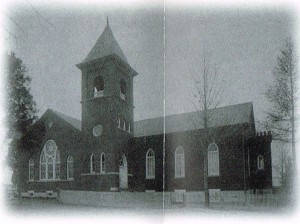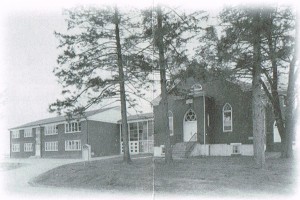History of Our Church
“The Reformed Church in the United States is the direct outgrowth of the Reformed Church of Germany and Switzerland and the Heidelburg Catechism is the only standard of faith received by it,” states the Rev. D. W. Gerhard in his History of The New Holland Charge.
Throughout Europe during much of the 16th, 17th, and early 18th centuries a great amount of religious unrest and persecution took place. Much suffering was endured to maintain the doctrines of Reformation.
The rich, productive Palatinate region of Germany along the Rhine was laid waste from wars, uprooting the Palatinate Germans. Louis XIV’s revocation of the Edict of Nantes in 1685 accounted for thousands more. Wars, persecutions, land taxes, all had an impact. Feudalism was still a part of life for many peasants.
In contrast was a new, undeveloped country, America, offering a chance for freedom. William Penn encouraged development in his vast land grant, and ship owners came to realize the profit in emigration.
Lancaster County, once a section of Chester County (which was known as Conestoga), was established in 1729. The future city of Lancaster was established in 1730. However, Salem Church was already a place of worship for the Palatinate German settlers.

First Log Church
Undoubtedly one of the earliest Reformed churches in this country and perhaps the earliest Reformed church in this county, is our own Salem Church at Hellers.
Early in the 18th century, mostly through ports on the Delaware, arrived the future founders, organizers, and leaders who would become the Reformed Church in Pennsylvania. It is unfortunate that the earliest Salem Church records were either not kept or were lost. What is available is indistinct or incomplete. Remember, however, the circumstances: most settlers arrived here minus their ministers, new congregations had to be organized, and record keeping did not, perhaps, have a high priority or was a frustrating assignment for such a small scattered group.
The names of two of these early church organizers most consistently mentioned regarding Salem Church are John Conrad Templeman and John Philip Boehm.
Templeman, a pious tailor from Heidelburg, Germany, was born in 1692 and arrived before 1725 in America. He settled in the Conestoga Valley of Leacock Township, Lancaster County. His efforts of organization were fruitful, and as a layman writing to the Church Synod of Holland in 1733 mentions, “The church of Conastocka had its origin in the year 1725 but on account of lack of a minister, without the administration of baptism and Lord’s Supper.” Templeman wasn’t ordained until 1752.
Meanwhile, John Philip Boehm, born 1683 in Germany, son of a Reformed minister, had been a schoolmaster in his homeland. By popular demand he reluctantly consented to begin a ministry in Philadelphia County. Word of Boehm’s success as organizer, leader, and minister spread west where he had been invited to visit and service congregations in the Conestoga district. In a letter to the Classis of Amsterdam dated January 14, 1739, he writes: “This district of Conestoga is very extensive. The first congregation which has gathered here I call Berg Kirche (Hill Church)”… Quoted from the Rev. Joseph H. Dubbs, D.D., Earliest Reformed Church in Lancaster County. Boehm served them first in 1727 and after ordination in 1729 administered baptism and communion for two more years, but distance was a factor: “twenty-one hours,” about 63 miles from his Philadelphia County charges.
Rev. Dubbs further notes: “The earliest deed may possibly be lost, but there is a grant dated February 11, 1743, from Philip Scott to John Line and Michael Weidler of two acres of land adjoining to Jacob Hillier’s (Heller’s) land whereon the meeting house now stands for the use of the same church in Leacock.” Upper Leacock Township wasn’t established until 1843.
Michael Weidler’s red sandstone marker with hourglass, skull and crossbones, can still be found in the churchyard, where it was placed in 1770. A more recent plain stone stands beside the original, listing Michael Weidler died 1770 aged 64 years and 10 months.
The Reverend D. W. Gerhard, in his History of the New Holland Charge, informs us that in the absence of a regular pastor the members frequently attended public worship at Lancaster and generally received communion there. The churchyard, however, has been continuously used for burial.
The Rev. Daniel Hertz became pastor at Heller’s in 1830, holding his first communion May 22, 1831, with a congregation that numbered sixteen. There was at that time a small log church which occasionally offered public worship, but no regular pastor had for a long time been stationed there. One service every four weeks, and those exclusively in German, was all Pastor Hertz could give Salem Church. However, starting in 1838 the congregation had a choice of attending German or English sermons.
When in 1860 a new building was dedicated, members recalled their heritage and included a corner stone engraved with the words “Founded A.D. 1722.” They also reported that their first house was built in 1722, repaired in 1802, rebuilt and enlarged in 1838 by the same congregation, the name of the house to be the same as heretofore – Salem. (Rev. D. W. Gerhard’s History of the New Holland Charge.)
In 1867 Rev. Darius William Gerhard became pastor of Salem Church, succeeding Pastor Hertz. Beginning in 1896 a new sanctuary was attached to the 1860 structure.
The church and church school continued to grow. In 1898 Salem was constituted a charge by itself, making Rev. Gerhard the first full time minister.
In 1934 additional room was made available for the church school by excavating under the floor of the existing church.
An educational building was attached in 1958 to the 1860 and 1896 buildings, and a center aisle created in the sanctuary.
Major remodeling in 1973 of the sanctuary included enlarging the foyer, adding rooms in the lower level for choir and church offices, and a small chapel.
Taking advantage of modern technology, air conditioning for the sanctuary was installed in 1976. In 1995, an elevator and other handicap accessibility additions were added to the front of the church. This renovation also included the construction of an archives display room.
This completes the physical building, seen today, dedicated to God’s work in today’s world. Present and future success of this heritage rests with the present and future congregations and God’s guidance.

Present day



